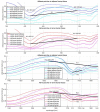Near-Infrared Spectral Similarity between Ex Vivo Porcine and In Vivo Human Tissue
- PMID: 36836713
- PMCID: PMC9959888
- DOI: 10.3390/life13020357
Near-Infrared Spectral Similarity between Ex Vivo Porcine and In Vivo Human Tissue
Abstract
Background: In vivo diffuse reflectance spectroscopy provides additional contrast in discriminating nerves embedded in adipose tissue during surgery. However, large datasets are required to achieve clinically acceptable classification levels. This study assesses the spectral similarity between ex vivo porcine and in vivo human spectral data of nerve and adipose tissue, as porcine tissue could contribute to generate large datasets.
Methods: Porcine diffuse reflectance spectra were measured at 124 nerve and 151 adipose locations. A previously recorded dataset of 32 in vivo human nerve and 23 adipose tissue locations was used for comparison. In total, 36 features were extracted from the raw porcine to generate binary logistic regression models for all combinations of two, three, four and five features. Feature selection was performed by assessing similar means between normalized features of nerve and of adipose tissue (Kruskal-Wallis test, p < 0.05) and for models performing best on the porcine cross validation set. The human test set was used to assess classification performance.
Results: The binary logistic regression models with selected features showed an accuracy of 60% on the test set.
Conclusions: Spectral similarity between ex vivo porcine and in vivo human adipose and nerve tissue was present, but further research is required.
Keywords: adipose tissue; classification; diffuse reflectance spectroscopy; nerve tissue; spectra.
Conflict of interest statement
The authors declare no conflict of interest. The funders had no role in the design of the study; in the collection, analyses, or interpretation of data; in the writing of the manuscript; or in the decision to publish the results.
Figures





Similar articles
-
Differentiation between nerve and adipose tissue using wide-band (350-1,830 nm) in vivo diffuse reflectance spectroscopy.Lasers Surg Med. 2014 Sep;46(7):538-45. doi: 10.1002/lsm.22264. Epub 2014 Jun 4. Lasers Surg Med. 2014. PMID: 24895321
-
Automated Spectroscopic Tissue Classification in Colorectal Surgery.Surg Innov. 2015 Dec;22(6):557-67. doi: 10.1177/1553350615569076. Epub 2015 Feb 3. Surg Innov. 2015. PMID: 25652527
-
Monitoring of tissue optical properties during thermal coagulation of ex vivo tissues.Lasers Surg Med. 2016 Sep;48(7):686-94. doi: 10.1002/lsm.22541. Epub 2016 Jun 1. Lasers Surg Med. 2016. PMID: 27250022
-
[Application of near infrared reflectance spectroscopy to predict meat chemical compositions: a review].Guang Pu Xue Yu Guang Pu Fen Xi. 2013 Nov;33(11):3002-9. Guang Pu Xue Yu Guang Pu Fen Xi. 2013. PMID: 24555369 Review. Chinese.
-
Impact of contact pressure-induced spectral changes on soft-tissue classification in diffuse reflectance spectroscopy: problems and solutions.J Biomed Opt. 2014 Mar;19(3):37002. doi: 10.1117/1.JBO.19.3.037002. J Biomed Opt. 2014. PMID: 24604537 Review.
Cited by
-
Evaluation of Diffuse Reflectance Spectroscopy Vegetal Phantoms for Human Pigmented Skin Lesions.Sensors (Basel). 2024 Oct 31;24(21):7010. doi: 10.3390/s24217010. Sensors (Basel). 2024. PMID: 39517908 Free PMC article.
-
Assessment of the Electrolyte Heterogeneity of Tissues in Mandibular Bone-Infiltrating Head and Neck Cancer Using Laser-Induced Breakdown Spectroscopy.Int J Mol Sci. 2024 Feb 23;25(5):2607. doi: 10.3390/ijms25052607. Int J Mol Sci. 2024. PMID: 38473853 Free PMC article.
-
Laparoscopic hyperspectral imaging for in vivo detection of the vagal nerve in upper gastrointestinal surgery.Surg Endosc. 2025 Aug 11. doi: 10.1007/s00464-025-12028-1. Online ahead of print. Surg Endosc. 2025. PMID: 40789779
-
Near-Infrared Spectroscopic Mapping of the Human Epicardium.J Biophotonics. 2025 Mar;18(3):e202400464. doi: 10.1002/jbio.202400464. Epub 2025 Jan 18. J Biophotonics. 2025. PMID: 39825702
References
-
- Chiang F.-Y., Lu I.-C., Chen H.-C., Chen H.-Y., Tsai C.-J., Hsiao P.-J., Lee K.-W., Wu C.-W. Anatomical variations of recurrent laryngeal nerve during thyroid surgery: How to identify and handle the variations with intraoperative neuromonitoring. Kaohsiung J. Med. Sci. 2010;26:575–583. doi: 10.1016/S1607-551X(10)70089-9. - DOI - PMC - PubMed
Grants and funding
LinkOut - more resources
Full Text Sources

